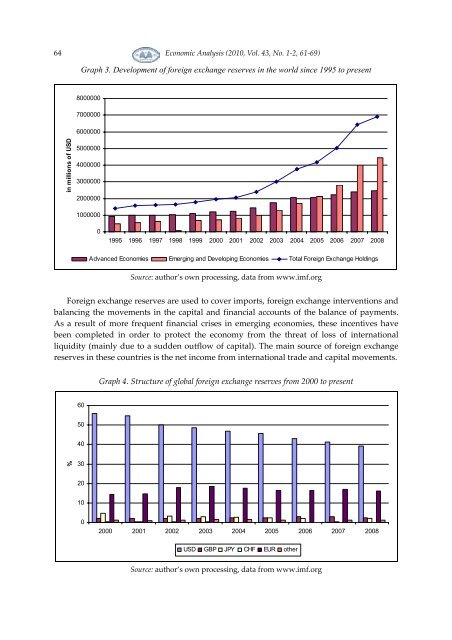Twice a Year Scientific Journal
Twice a Year Scientific Journal
Twice a Year Scientific Journal
You also want an ePaper? Increase the reach of your titles
YUMPU automatically turns print PDFs into web optimized ePapers that Google loves.
64<br />
Economic Analysis (2010, Vol. 43, No. 1-2, 61-69)<br />
Graph 3. Development of foreign exchange reserves in the world since 1995 to present<br />
8000000<br />
7000000<br />
6000000<br />
in millions of USD<br />
5000000<br />
4000000<br />
3000000<br />
2000000<br />
1000000<br />
0<br />
1995 1996 1997 1998 1999 2000 2001 2002 2003 2004 2005 2006 2007 2008<br />
Advanced Economies Emerging and Developing Economies Total Foreign Exchange Holdings<br />
Source: author’s own processing, data from www.imf.org<br />
Foreign exchange reserves are used to cover imports, foreign exchange interventions and<br />
balancing the movements in the capital and financial accounts of the balance of payments.<br />
As a result of more frequent financial crises in emerging economies, these incentives have<br />
been completed in order to protect the economy from the threat of loss of international<br />
liquidity (mainly due to a sudden outflow of capital). The main source of foreign exchange<br />
reserves in these countries is the net income from international trade and capital movements.<br />
Graph 4. Structure of global foreign exchange reserves from 2000 to present<br />
60<br />
50<br />
40<br />
%<br />
30<br />
20<br />
10<br />
0<br />
2000 2001 2002 2003 2004 2005 2006 2007 2008<br />
USD GBP JPY CHF EUR other<br />
Source: author’s own processing, data from www.imf.org
















